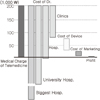Abstract
As Information Technology has developed, there has been a birth of new medical fields including telemedicine, e-Health, and u-Health. The differences between the new terms resulted from renewed definitions with the development of technology. However, aside from the simple change in terminology medical services that use the terms has expanded along with the change in terminology. Currently most countries use telemedicine as a part of their healthcare system. As such, related devices and services have been slated to become a totally new industry. In Korea, due to the advances in IT, Increase in medically vulnerable and aging population, and increase in the number of patients with chronic disease, telemedicine has been widely used in public healthcare system. Several developmental attempts by public and private sectors have had limited success due to legal and institutional limitations but recent changes in medical law and movement to allow tele-diagnosis and treatment in the public sector has brought in a new era. Although development of telemedicine technology may be the key, it is even more important that the development in medical services models as well as their application be on the same track. Furthermore, from the clinical and academic standpoint, the aspects of safety, efficiency, and economic viability must be thoroughly tested and applied. Most importantly, active involvement from the medical community in development of new medical technology as well as new service models for diagnosis and treatment is required. The most advanced technology would be useless if it is not being actively utilized by the medical community in the treatment and management of patients.
Figures and Tables
References
1. Greenes RA, Shortliffe EH. Medical informatics. An emerging academic discipline and institutional priority. JAMA. 1990. 263:1114–1120.

4. Morrison I. Health care in the new millennium. 2000. San Francisco: Jossey-Bass Publishers.
5. Lee WJ. Robotics and gstrointestinal surgury. J Korean Soc Endosc Laparosc Surg. 2005. 8:41–46.
6. McGee MK. e-Health on the horizon. Information Week. 2004. 53–67.
7. Douglas A, Perednia DA, Allen A. Telemedicine technology and clinical applications. JAMA. 1995. 273:483–488.

8. Linkous JD. Toward a rapidly evolving definition of telemedicine. 2001. Accessed February 5, 2003. Washington, DC: American Telemedicine Association;Available at:
www.atmeda.org/news/definition.html.
9. Ryoo SW, Jo JK, Song TM, Lee SY, Kang EJ, Jang WI, Lee HS, Ahn ME, Lee KE. Enhancing acceptance of telehealth for the public sector. 2004. Seoul: KIHASA;28–35.
10. Hersh WR, Hickman DH, Severance SM, Dana TL, Krages KP, Herfand M. Telemedicine for the medicare population: update. 2004. Portland, OR: Agency for healthcare Research and Quality. Oregon Evidence-Based Practice Center.
11. Brantley D, Laney CK, Spivack R. Innovation, demand, and investment in telehealth. 2004. Washington D.C.: United States Department of Commerce, Office of Technology Policy.
12. Jennett P, Scott R, Hailey D, Ohinmaa A, Thomas R, Anderson C, Young B, Lorenzetti D, Hall LA, Milkovich L, Perverseff T, Claussen C. Socio-economic impact of tele-health: evidence now for health care in the future. 2003. University of Calgary.
13. Chung YC, Sin YJ, Chung YH, Choi EJ, Ko SJ, Kim DS, Kim JE, Lee KJ, Jo BH, Hong SK. A study on e-Health policy scheme in Korea. 2005. Seoul: KIHASA.
14. Ji KY, Kim DS, Kim JH, Park RW, Lee YH, Lee KH, Lee HJ, Ryoo SH, Chae YM, Kim SB, Lee SK, Kim IK, Park YS. Heath system of ubiquitous era. 2005. Seoul: Jihan M&B;46–58.
15. Schwartz KL, Roe T, Northrup J, Meza J, Seifeldin R, Neale AV. Family medicine patients' use of the internet for health information: A MetroNet Study. J Am Board Fam Med. 2006. 19:39–45.

16. Cuung HT, Kim JA. Utilization of internet-based medical information services and hospital selection among health care consumers: internet survey. J Korean Soc Med Inform. 2005. 11:125–136.

17. Mayer MA, Karkaletsis V, Archer P, Ruiz P, Stamatakis K, Leis A. Quality labelling of medical web content. Health Informatics Journal. 2006. 12:81–87.

18. Eysenbach G, Kohler C. How do consumers search for and appraise health information on the world wide web? Qualitative study using focus groups, usability tests, and in-depth interviews. BMJ. 2002. 324:573–577.

19. Nam SI, Kim MK, Lee CY, Han CH. Development of investment evaluation model for ubiquitous health service. Journal of Information Technology Applications & Management. 2008. 15:183–202.
20. Einthoven W. Le telecardiogramme. Arch Int de Physiol. 1906. 4:132–164.
21. Bashshur R. Technology serves the people: The story of a cooperative telemedicine project by NASA, the Indian Health Service and the Papago people. 1980. Washington, D.C.: Superintendent of Documents, US Government Printing Office;110.
22. Whitten P, Buis L. Private payer reimbursement for telemedicine services in the United States. Telemedicine and e-Health. 2007. 13:15–24.

23. Kollmann A, Riedl M, Kastner P, Schreier G, Ludvik B. Feasibility of a mobile phone-based data service for functional insulin treatment of type 1 diabetes mellitus patients. J Med Internet Res. 2007. 5:9–36.

24. Green BB, Cook AJ, Ralston JD, Fishman PA, Catz SL, Carlson J, Carrell D, Tyll L, Larson EB, Thompson RS. Effectiveness of home blood pressure monitoring, web communication, and pharmacist care on hypertension control: A Randomized Controlled Trial. JAMA. 2008. 299:2857–2857.

25. Lee YT, Park JS, Kang DW, Kim SY, Ryoo SW, Park DK, Park SB, Lee SH, Jung EY. The evaluation of u-Health pilot project. 2009. KHIDI;3–25.




 PDF
PDF ePub
ePub Citation
Citation Print
Print






 XML Download
XML Download